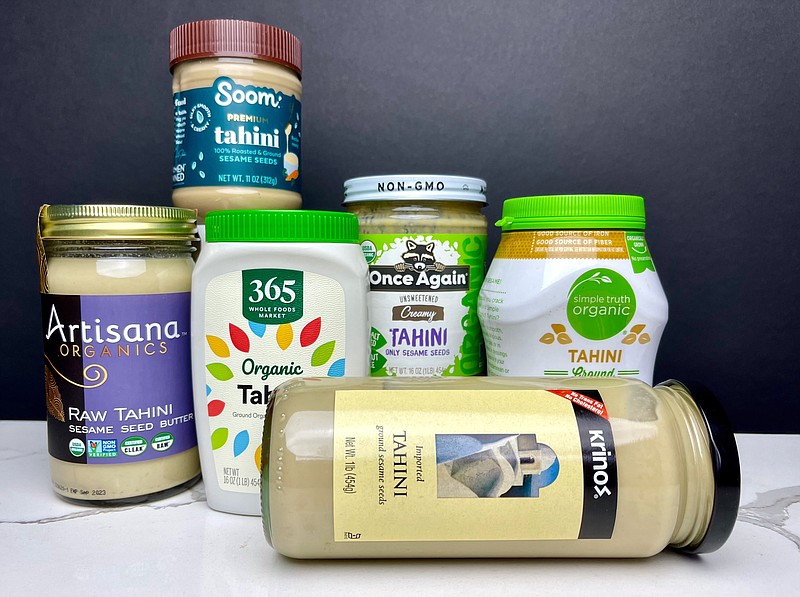Tahini may be new to American cooks, but the rich, nutty condiment has been part of Middle Eastern and Mediterranean cuisine for centuries, if not millennia.
If you've eaten hummus, you've had tahini.
Premium tahini is made using a single ingredient: Sesame seeds. That's it. No salt. No sugar. No additional oils. No emulsifiers. Just sesame seeds.
Although high in fat, tahini is also high in protein, fiber, calcium, magnesium and iron — making it a powerhouse of a condiment.
In the not-so-distant past, if an Arkansas cook needed tahini for a recipe she used whatever brand her grocery store kept in stock — if they stocked it at all. Today, many grocery stores around Little Rock (and other metropolitan-ish parts of the state) offer a wide variety of brands of tahini. Not to mention the numerous Middle Eastern grocery stores and of course, the internet, where one can buy most anything her heart desires.
In just a decade or so we've gone from the hard part being finding tahini in the first place to narrowing down which brand to buy. (We should note, however, that general merchandise stores that also sell groceries have been slower to board the tahini train.)
To help make that choice easier, we had a taste test, sampling several of the brands available in Central Arkansas and other populous parts of the state. We judged for flavor, consistency, texture and stir-ability. Oil separation is natural and normal and should be expected so stirring is always necessary with tahini, but we found it easier to stir some brands back together than others. Also, the longer the tahini sits on the shelf at the store or in your pantry, the more it will settle and separate. (Prices are current as of Oct. 13.)
Ranked in order of preference:
Soom: This was the smoothest and creamiest tahini we tried. It has a thinner consistency than most and is easy to stir (or shake) after separation. The flavor is rich with a pleasing bitter edge. (About $6.49 for 11 ounces)
365 (Whole Foods private label): This super smooth tahini was the easiest to stir of the six we tried. One of the two tahinis we tried that includes salt, it has a nice nutty flavor. (About $6.99 for 16 ounces)
Krinos: Similar in taste and texture to Soom, this tahini has a mild, creamy flavor and is available at several of the grocery stores we checked. Our major complaint about this tahini is the packaging. The tall, narrow jar made it difficult to stir and re-incorporate the oil and we needed a long-handled spoon to dip and keep our fingers clean. (About $8.19 for 16 ounces)
Once Again: This tahini is made with dry-roasted sesame seeds, giving it a deep, toasty flavor and rich golden color. The texture is marginally gritty, but not unpleasantly so. It is sufficiently thick for spooning, but not so thick you can't drizzle it. This tahini took a bit of work to stir back together, but once stirred and refrigerated, it held together. (About $9.50 for 16 ounces)
Simple Truth (Kroger private label): This tahini was our go-to for many years thanks to its budget-friendly price and availability at our neighborhood Kroger. This tahini is slightly less bitter than most, thanks to the salt; however, it has an aftertaste the others we tried lack, which why it is no longer our go-to. You'll need to put in a little work to stir this tahini back together. (About $5.99 for 16 ounces)
Artisana: This tahini is made from raw sesame seeds. It has a fresher (greener, even) and much milder flavor than the others. The consistency is on the thick side — definitely too thick for drizzling — and it is rather gritty. The jar we bought needed minimal stirring to reincorporate the oil. (About $11.29 for 14 ounces)
If you find your tahini has separated to the point that no amount of stirring or whisking by hand is going to bring it back together, transfer the whole jar to a food processor or blender, and whirr it until you have a smooth, homogenous mixture again. Like natural peanut butter, storing the tahini upside down or in the refrigerator can slow the separation process.
We also tried our hand at making tahini using recipes we found in "Middle Eastern Sweets: Desserts, Pastries, Creams & Treats" by Salma Hage and on the back of the Bob's Red Mill sesame seeds package. However, we should note that because this method includes olive oil, it is not true tahini. You'll want to use the mildest olive oil you have as you will be able to taste it. The consistency of our homemade tahini blended using our ancient (30+ years old) food processor fell in the middle on the silky scale.
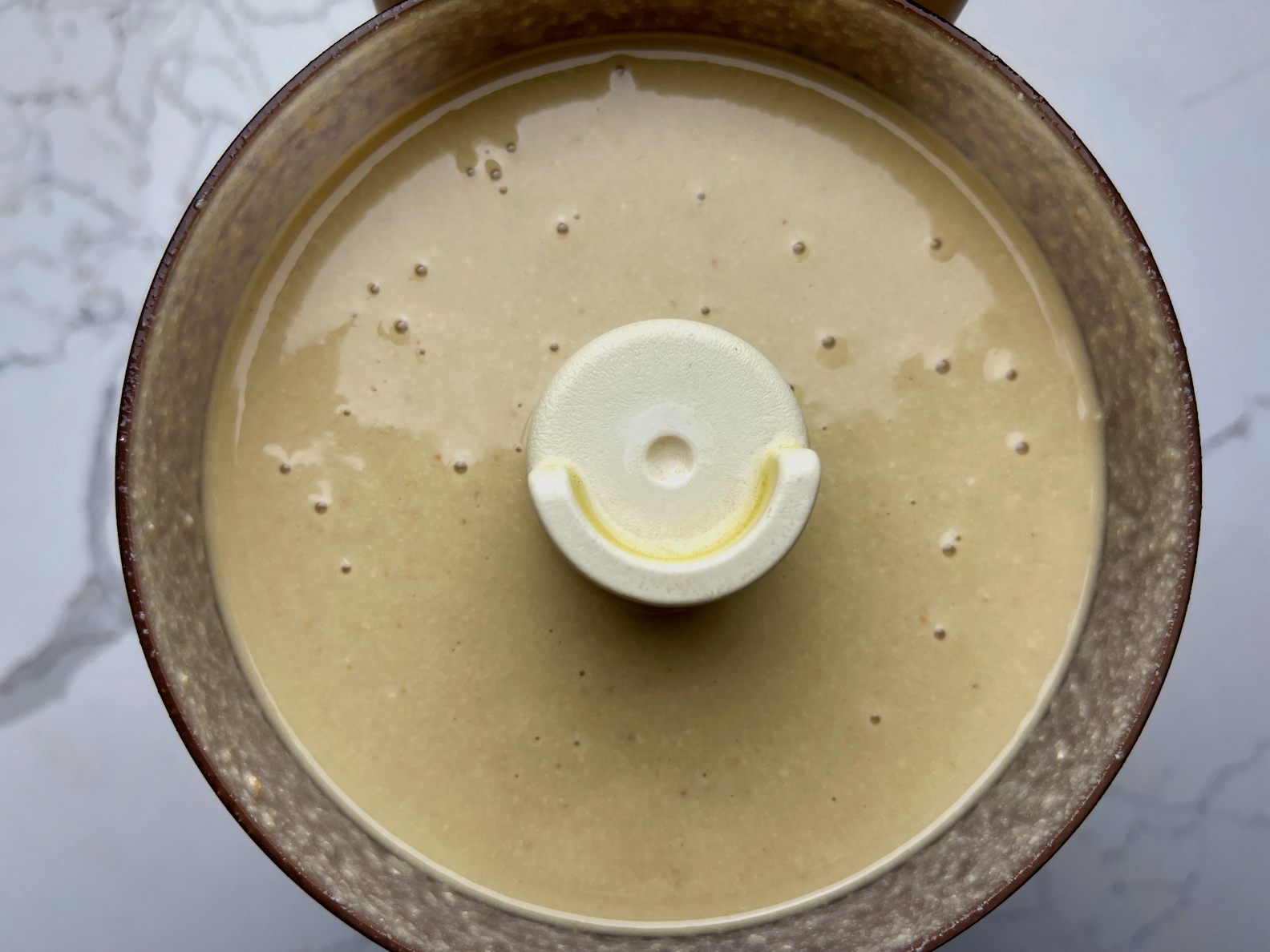 DIY Tahini made with toasted sesame seeds and olive isn't as good as store-bought, but it'll work in a pinch. (Arkansas Democrat-Gazette/Kelly Brant) Tahini is one of the rare food items where homemade doesn't beat store bought. But it'll do in a pinch.
DIY Tahini made with toasted sesame seeds and olive isn't as good as store-bought, but it'll work in a pinch. (Arkansas Democrat-Gazette/Kelly Brant) Tahini is one of the rare food items where homemade doesn't beat store bought. But it'll do in a pinch.
DIY Tahini
- Scant 2 cups hulled sesame seeds
- ½ cup olive oil
- 1 teaspoon salt, optional
Heat oven to 350 degrees. Spread the sesame seeds out in an even layer on a rimmed baking sheet. Toast the seeds for 10 minutes, stirring occasionally to ensure even browning. Let cool for 20 minutes.
Once cool, transfer toasted seeds to a food processor. With the motor running, dribble in the oil. Process until smooth and creamy. Season to taste with salt, if desired.
Makes about 1 ½ cups.
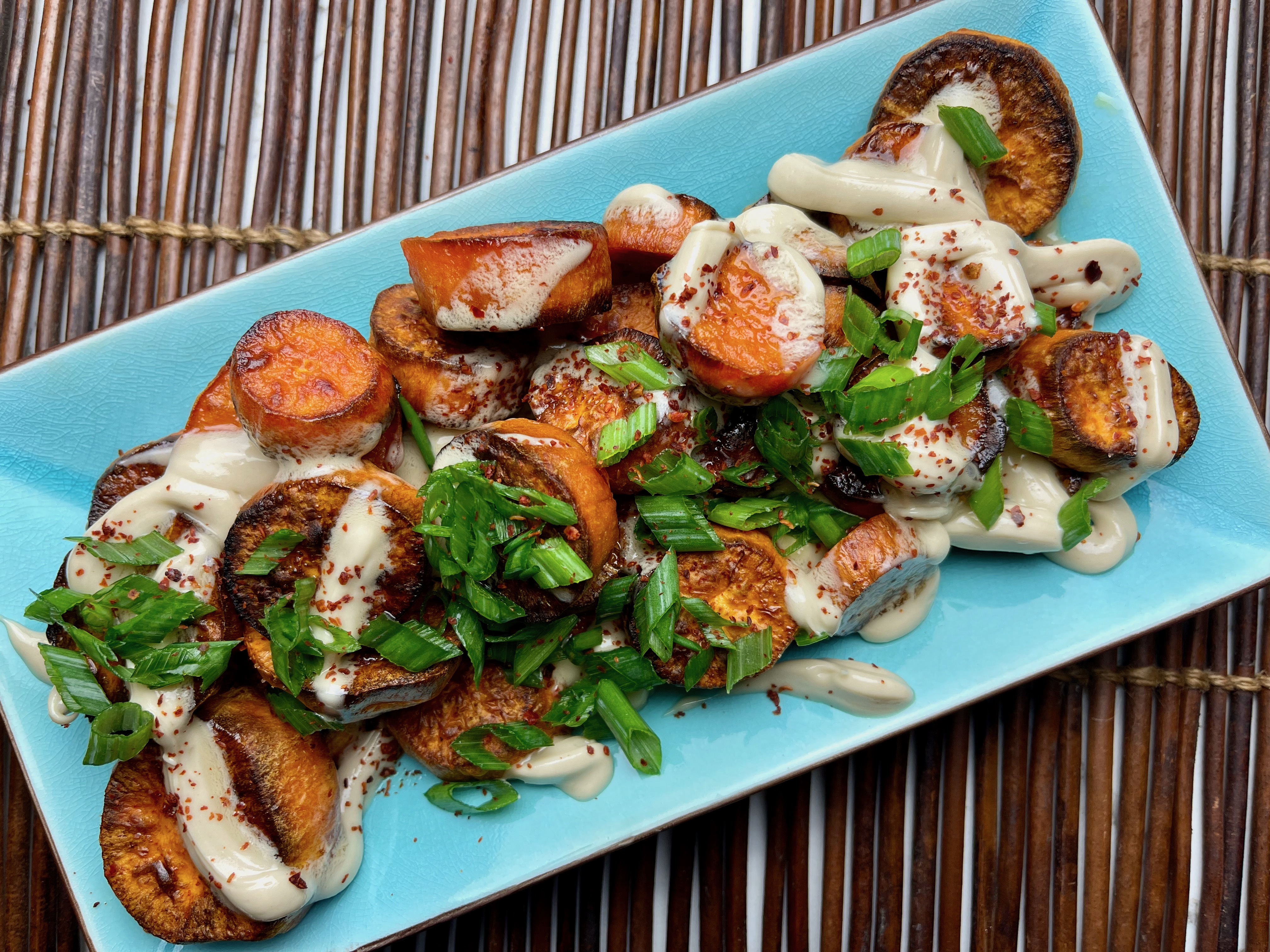 Sweet Potatoes With Tahini Butter (Arkansas Democrat-Gazette/Kelly Brant) To make these sweet potatoes meltingly tender, they are steamed and then roasted before getting topped with a drizzle of tahini-butter and a sprinkle of green onion. If that sounds like too much work, simply bake, slash and top the potatoes with the tahini-butter, green onion and red chile flakes.
Sweet Potatoes With Tahini Butter (Arkansas Democrat-Gazette/Kelly Brant) To make these sweet potatoes meltingly tender, they are steamed and then roasted before getting topped with a drizzle of tahini-butter and a sprinkle of green onion. If that sounds like too much work, simply bake, slash and top the potatoes with the tahini-butter, green onion and red chile flakes.
Sweet Potatoes With Tahini-Butter
- Olive oil
- 1 ¾ to 2 pounds sweet potatoes, peeled and cut into thick (about ¾-inch) chunks
- Salt
- ¼ cup butter, softened
- 2 to 3 tablespoons tahini
- 2 or 3 green onions, thinly sliced
- Red chile flakes for sprinkling
Heat oven to 425 degrees. Line a 13-by-9-inch pan with foil or parchment paper.
Add enough olive oil to the pan to coat the bottom. Arrange the sweet potato rounds in the pan in a single layer, sprinkle with salt and then flip each slice over to coat in the oil. Cover the pan tightly with foil.
Roast for 30 minutes, remove foil, and continue roasting for 15 minutes more; carefully flip each potato and continue roasting until tender and browned, about 10 minutes more. Let cool while you prepare the tahini-butter.
In a small bowl, whisk together the butter, tahini and a couple of tablespoons of cold water. It won't seem like it's going to come together at first, but keep whisking, it will.
Transfer the potatoes to a serving platter. Spoon the tahini-butter over the potatoes or transfer it to a small zip-close bag, snip off one corner and squeeze it over the potatoes. Top with green onions and chile flakes.
Serve immediately.
Makes about 4 servings.
Recipe inspired by "Persiana Everyday" by Sabrina Ghayour and "The Mediterranean Dish" by Suzy Karadsheh
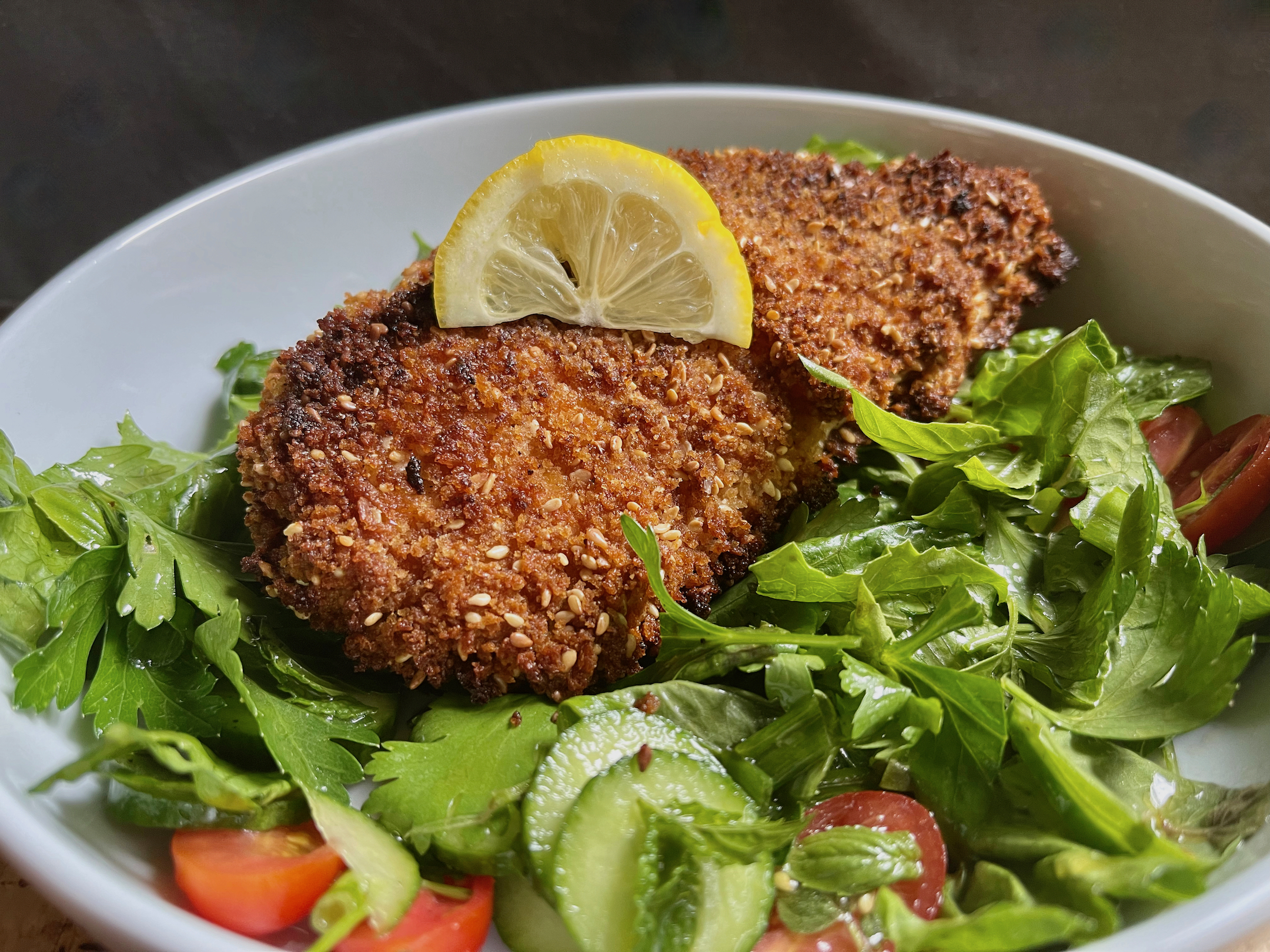 Middle Eastern Chicken Milanese (Arkansas Democrat-Gazette/Kelly Brant) Whether you know it as schnitzel, Milanese or katsu, a breaded and pan-fried chicken cutlet makes a delicious main dish.
Middle Eastern Chicken Milanese (Arkansas Democrat-Gazette/Kelly Brant) Whether you know it as schnitzel, Milanese or katsu, a breaded and pan-fried chicken cutlet makes a delicious main dish.
This version puts a Middle Eastern spin on breaded cutlets with the addition of tahini and sesame seeds as well as a bit of heat from cayenne and smoked paprika.
Leftover cutlets can be re-heated and re-crisped in a 400-degree oven, toaster oven or air fryer.
Middle Eastern Chicken Milanese
- 2 lemons, divided use
- 3 tablespoons olive oil
- Salt and ground black pepper
- 1 pound cherry or grape tomatoes, quartered
- 2 cups baby arugula (see notes)
- ½ small red onion, thinly sliced (see notes)
- ½ cup tahini
- 1 egg
- ¼ teaspoon ground cayenne pepper
- 2 cups panko (Japanese-style breadcrumbs)
- 3 tablespoons sesame seeds (not toasted)
- ½ teaspoon hot smoked paprika (see notes)
- 1 pound boneless, skinless chicken breasts or cutlets
- Vegetable oil, for frying
Zest and juice one of the lemons. Cut the remaining lemon into wedges; set the wedges aside.
In a medium bowl, whisk together the lemon zest and juice and the olive oil. Season to taste with salt and pepper. Add the tomatoes, arugula and red onion. Toss gently to combine. Set aside while you prepare the chicken.
In a wide, shallow dish, whisk together the tahini, 6 tablespoons water, the egg, ½ teaspoon salt, the cayenne and about ¼ teaspoon ground black pepper.
In a separate wide, shallow dish combine the panko, sesame seeds, 1 teaspoon salt, smoked paprika and ½ teaspoon ground black pepper.
If using chicken breasts, lay each breast flat on a cutting board and then holding the blade of a chef's knife parallel to the board, cut each breast into ¼-to ½-inch thick cutlets.
Line a baking sheet with parchment paper.
Working with one piece at a time, dip chicken in the tahini mixture, letting the excess drip off. And then coat both sides with panko mixture, pressing to adhere. Lay the breaded cutlets on the prepared baking sheet. Repeat until all cutlets have been coated in both mixtures. Let the cutlets rest while you heat the oil.
Add enough vegetable oil to a large, heavy skillet to fill ¼ to ½ inch. Heat oil over medium-high heat. To test the oil's temperature drop a piece of torn white bread into the hot oil. If it sizzles and turns golden almost immediately, the oil is hot enough. Fry the cutlets, two at a time (or as many was will comfortably fit without touching), until golden and crisp, 2 to 3 minutes on each side. Drain on paper towels.
Serve with remaining lemon wedges.
Makes 4 servings.
Notes: I added a sliced cucumber and substituted a mix of romaine, parsley, mint, basil, cilantro, oregano, thyme and green onions for the arugula and red onion — heavy on the herbs, light on the lettuce.
I used a combination of sweet smoked paprika and ground cayenne.
Recipe adapted from "Tahini" by Adeena Sussman (Short Stack, Vol. 23)
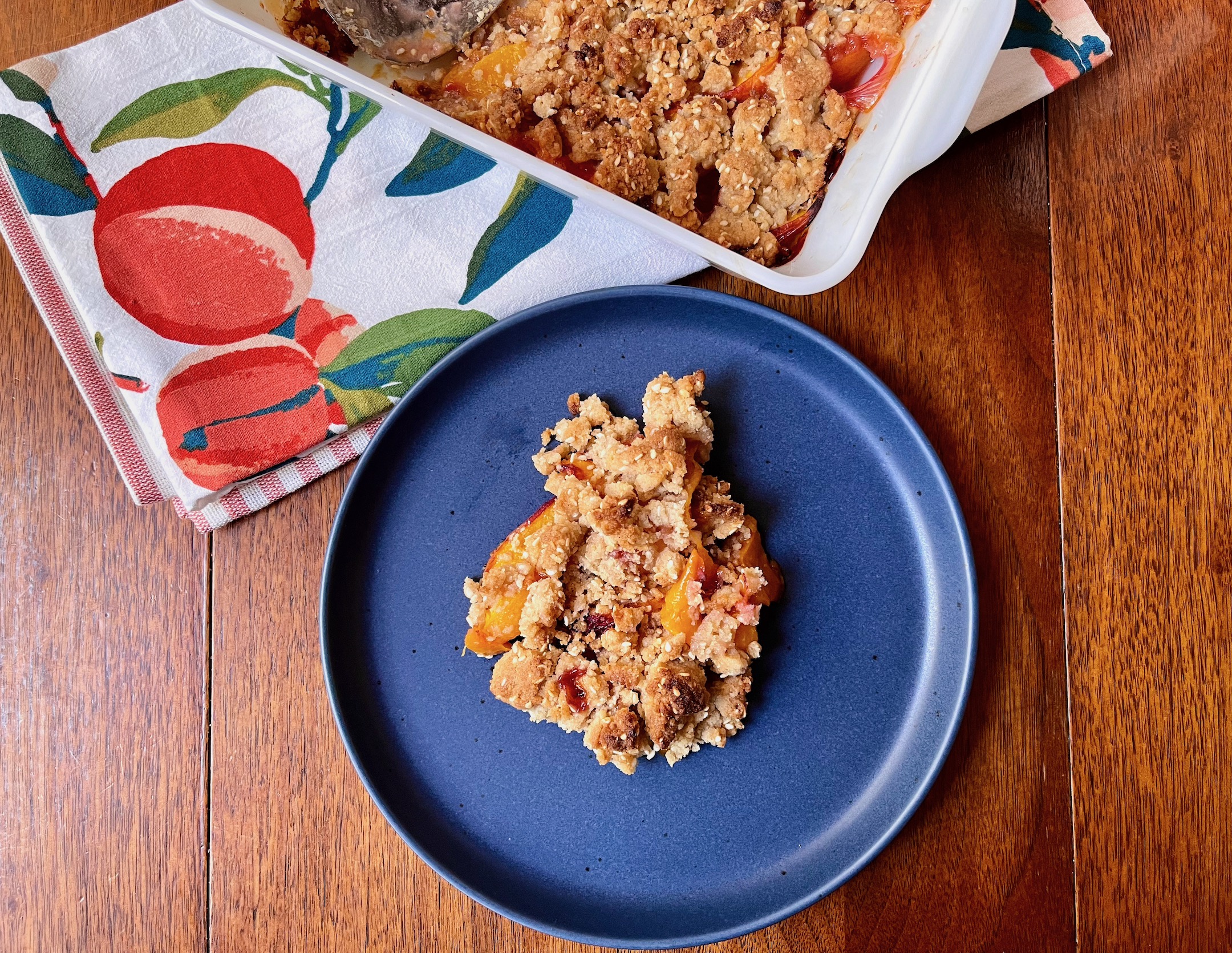 Peach Sesame Crumble (Arkansas Democrat-Gazette/Kelly Brant) Peaches and sesame seeds may not seem like natural partners, but they're a match made in dessert heaven in this easy crumble.
Peach Sesame Crumble (Arkansas Democrat-Gazette/Kelly Brant) Peaches and sesame seeds may not seem like natural partners, but they're a match made in dessert heaven in this easy crumble.
Peach Sesame Crumble
- 2 large ripe peaches OR 2 cups sliced frozen peaches, defrosted and drained
- Zest and juice of ½ small lemon, divided use
- ½ cup granulated sugar, divided use
- 1 ½ tablespoons sesame seeds
- Salt
- Heaping 1/3 cup all-purpose flour
- 2 ½ tablespoons butter
- 1/8 teaspoon ground cinnamon
- 1 ½ to 2 tablespoons tahini
- ¾ teaspoon sesame oil
- ¼ to ½ teaspoon cornstarch (see note)
Heat oven to 375 degrees.
Cut each peach in half and remove the pit. Cut each half into eight slices. Scatter the sliced peaches in the bottom of a small (1 ½ -quart) baking dish. Sprinkle with lemon juice and 1 tablespoon of the sugar. Set aside.
In a small skillet over medium-high heat, toast the sesame seeds, shaking the pan almost constantly so they do not burn. Transfer the toasted seeds to a large bowl. Add the flour, remaining sugar and a scant ½ teaspoon salt (less if using salted butter). Whisk to combine. Set aside.
In small, microwave-safe bowl, combine the butter, lemon zest and cinnamon. Microwave for 30 seconds or until butter is melted. Stir in the tahini and sesame oil. Pour the sesame-butter mixture over the flour-sesame seed mixture and stir until mixture is crumbly and holds together when squeezed into a ball.
Sprinkle the cornstarch over the peaches, using ¼ teaspoon if there is very little juice or ½ teaspoon if they've released a lot of juice. Toss to mix.
Scatter the sesame crumb mixture over the peaches. Bake until topping is well browned and firm and peaches are tender with bubbling juices, about 35 to 40 minutes.
Makes 2 to 3 generous servings.
Note: If using frozen peaches increase the cornstarch to ¾ teaspoon.
Recipe adapted from Bon Appetit
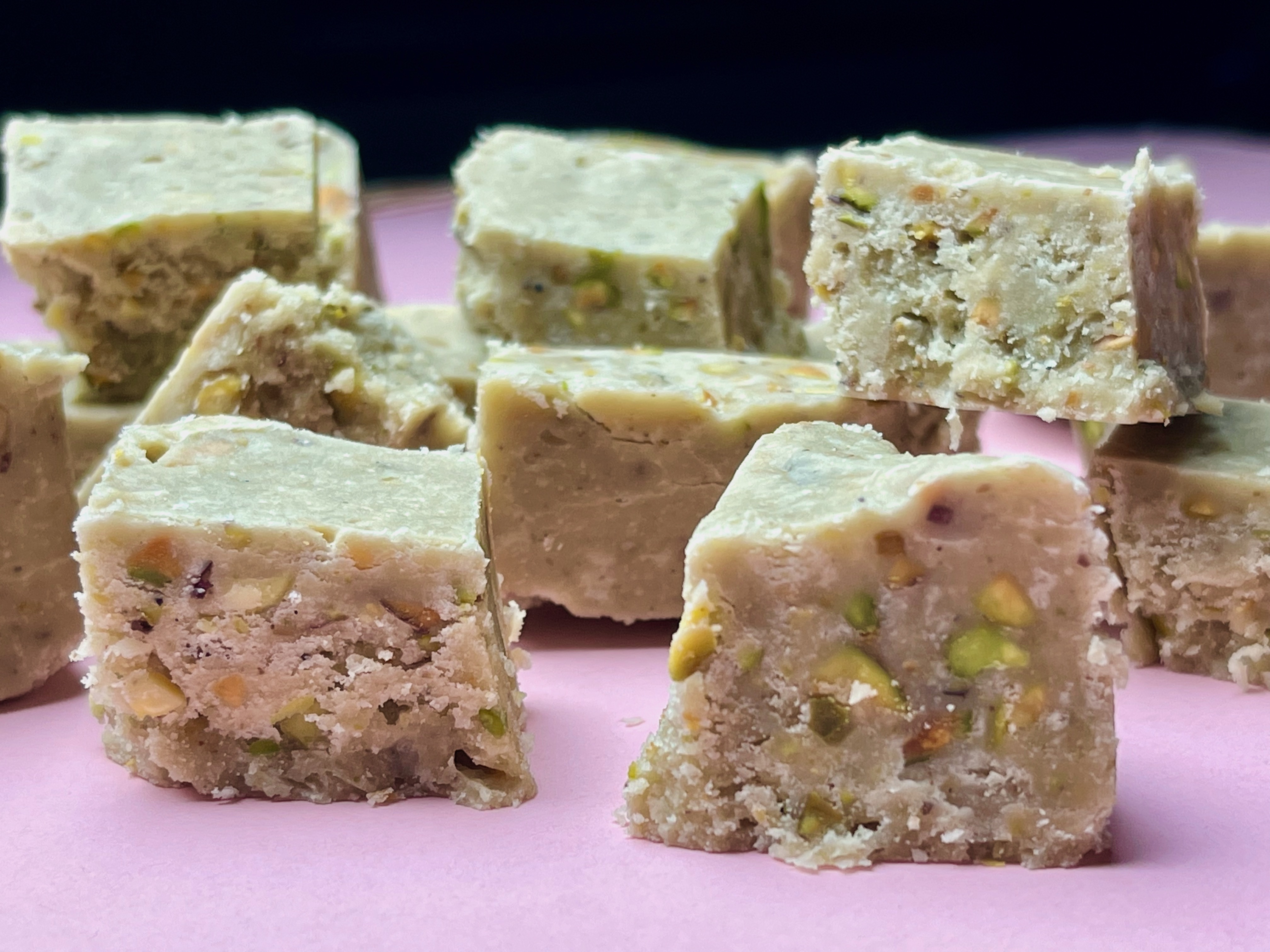 Cardamom Halvah With Pistachios (Arkansas Democrat-Gazette/Kelly Brant) Halvah is a fudge-like confection made with tahini, sugar, spices and often nuts such as pistachios or almonds. Like most candies, it can be a bit tricky to get perfect, but even if you mess it up, it'll still taste great. This version combines cardamom, spiced tea and pistachios, but really anything goes — chocolate or cacao nibs, sesame seeds, almonds, citrus, rose petals or rose water...
Cardamom Halvah With Pistachios (Arkansas Democrat-Gazette/Kelly Brant) Halvah is a fudge-like confection made with tahini, sugar, spices and often nuts such as pistachios or almonds. Like most candies, it can be a bit tricky to get perfect, but even if you mess it up, it'll still taste great. This version combines cardamom, spiced tea and pistachios, but really anything goes — chocolate or cacao nibs, sesame seeds, almonds, citrus, rose petals or rose water...
Cardamom Halvah With Pistachios
- Cooking spray, for greasing
- 1 ½ cups tahini
- 1 cup finely chopped pistachios
- 1 vanilla bean OR 1 tablespoon vanilla paste
- 2 cups granulated sugar
- 1 teaspoon ground cardamom
- ¾ teaspoon fine salt (¼ to ½ teaspoon if your pistachios are salted)
- ½ cup brewed chai or other spiced tea (see note)
Grease an 8- or 9-inch square baking pan with cooking spray and line the bottom with parchment paper. Have another piece of parchment ready to cover the top.
In a stand mixer fitted with the paddle attachment, combine the tahini and pistachios and mix until just incorporated. Turn mixer off.
If using a vanilla bean, split the bean in half lengthwise and use the tip of your knife to scrape the tiny black seeds from the pod. (Reserve the pod for another use, such as homemade vanilla sugar or extract.) In a medium saucepan, combine the sugar, vanilla, cardamom, salt and brewed tea. Cook over medium heat, stirring until the sugar is thoroughly moistened. Bring the mixture to a boil and cook without stirring until mixture reaches 240 to 242 degrees on a candy thermometer.
Immediately turn the stand mixer on medium-low speed and drizzle the hot syrup into the tahini-pistachio mixture — careful! Don't hit the moving paddle with the hot syrup. Mix just until the candy pulls away from the sides of the bowl, about 30 seconds.
Quickly pour or scrape the candy into the prepared pan and press the top flat with the extra sheet of parchment — careful! It's hot. Cool completely, preferably overnight, before cutting into squares.
Store tightly wrapped at room temperature for up to 1 week.
Makes about 1 pound.
Note: To give our halvah a hint of rose flavor we used English rose black tea.
Recipe adapted from "The Tahini Table: Go Beyond Hummus With 100 Recipes for Every Meal" by Amy Zitelman with Andrew Schloss
